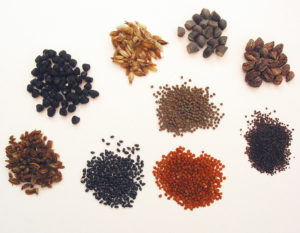 It might be a bit too hot for some people and many plants, but as always with gardening, whatever the weather, there are winners and losers. Due to the exceptional heat and dryness some plants are looking parched, but it’s a perfect year to save seed from flowers and vegetables.
It might be a bit too hot for some people and many plants, but as always with gardening, whatever the weather, there are winners and losers. Due to the exceptional heat and dryness some plants are looking parched, but it’s a perfect year to save seed from flowers and vegetables.
You might have noticed that the price of seeds has been edging ever higher with the average packet of even quite ordinary things coming in around £2.50 – £2.99. At £2.99 for only 6 tomato seeds making it 50p a seed, it starts to make growing your own a bit less attractive.
Now is the time to start thinking about what you might save to sow next year, walk around your garden and you’ll probably be surprised just how many seeds you could collect. Annual flowers such as: Cerinthe, Marigolds, Sweet peas, Cosmos, Zinnias, Antirrhinums, Foxgloves, Aquilegia, Lychnis, Cornflowers, Cleome, and Poppies are all setting seed at the moment and with the hot dry conditions it’s a perfect time to harvest them.
Collection is a simple process for most seeds and the secret to success is to choose the best plants to harvest; ones that don’t have pests or damage and are good mature specimens, then to clean and store the seed carefully.
Store only seed that has fully dried and even in this weather they might not have done so outside, so once you’ve checked your seed and got rid of any plant debris and pests, put it somewhere warm and dry for a few days to fully dry out. Seeds may seem inert, but they are not dead, so store them in paper envelopes (not plastic bags) so that they don’t go mouldy. Label the seeds with what they are and the year you gathered them (trust me you won’t remember!) then store in a tin or airtight box somewhere frost free, cool and dry. I always have a quick check on the internet with a commercial seed supplier to see when they advise sowing particular seeds and any extra treatments they might need (e.g soaking overnight or chilling to break dormancy etc) to get them to germinate, then write this on the envelope with the name and date and store them in order of the date of sowing .
If you want next years plants to be the same as this year’s, you need to remember that “F1 Hybrids” will not produce offspring that are like their parents. If you don’t mind the variation and unknown outcomes that’s fine, but otherwise avoid saving F1 seed (you need to look on the original seed packet to find out if they are F1 hybrids). You may also find that you have some wonderful cultivar which try as you might you can never get to grow from seed, disappointingly this may be because the plant is a ‘sterile hybrid’ that doesn’t produce viable seed, in which case the only way to propagate it will be by division or cuttings, depending on the plant.
On the vegetable front you can easily save seed from Beans, Peas, Tomatoes, Courgettes Pumpkins, Carrots, Lettuces and Peppers. However you need to beware that these aren’t F hybrids (as above). Also if you have grown a number of different varieties of beans, peas, pumpkins or courgettes near to one another they are quite promiscuous plants and will happily cross pollinate between varieties, so you might not get the plant you expected next year, but that can be part of the fun.
If you are saving Bean seed its tempting to just wait until the last sad, dried up pods are left on the plant, but if you want the best results next year, choose some really nice mature pods before the end of the fruiting season and put them aside to dry in their pods.
With fleshy seeds like tomatoes and pumpkins or courgettes you need to get rid of the surrounding flesh and let them dry out fully or they will not store until you want to use them. For tomatoes you also need to get rid of the jelly like coating around the seed and a good way to do this is to squeeze the seeds into a jar cover them with water and leave them for a few days on the window sill stirring occasionally. You will end up with some slightly evil smelling liquid with a bit of mould on the top, tip this away and discard any seeds that float, then put the remaining seeds onto a piece of kitchen roll and leave for another few days until they are completely dry before you store them.
Besides saving money, there is something deeply satisfying about growing plants from your own seed, so give it a go this year.